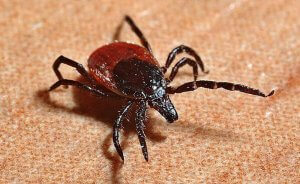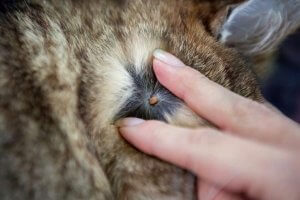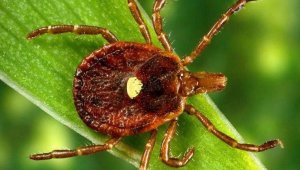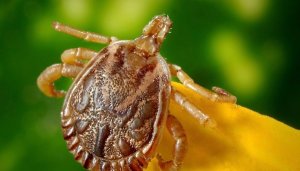Ticks are a part of life in Western Pennsylvania and 2019 is predicted to be “the year of the tick”. Closely related to mites, these parasitic insects feed mostly on the blood of warm-blooded mammals but some species attack birds, reptiles and even amphibians. Fish are apparently the only vertebrates not plagued by these little blood-suckers.
Many species of ticks pose a danger to human health as they transmit disease from an infected host to those that are healthy. Parasitic worms, viruses, bacteria, spirochetes and rickettsias are a few of the more frequently transmitted organisms to residents of Pennsylvania. The most dangerous are the spirochetes which cause Lyme disease, and rickettsias which cause Rocky Mountain Spotted Fever.
Read on to learn more about this pesky Summer nuisance and what preventative measures you can take to protect your home or business (and the family, friends, pets or employees that inhabit them), or if an infestation has occurred, immediately seek the help of our Quality Pro-Certified Pittsburgh pest control experts today! (412) 252-5200
Removing Ticks From Your Body
Ticks cannot feed immediately after latching on to a host, as their mouthparts require several hours to imbed themselves deeply enough into the skin. This makes it vital to promptly remove a tick from the skin as soon as it is noticed. Grasp it with tweezers, as close to the skin as possible, and pull it straight out.
Never grab a tick in the middle of its body because such action may cause the gut contents to be expelled into the skin. It is also not recommended to use heat (lit match, cigarette, etc.), or petroleum jelly to force the tick out.because this may cause the tick to regurgitate its stomach contents into its victim, and increase the odds of potential infection.
Climate Changes And Tick Populations

Milder winters create problems with tick populations in the spiring and summer seasons. According to insect experts, early warming of the earth translates into the perfect clime for tick explosions in numbers. These insects do not hibernate, and if temperatures are warm enough even if snow is on the ground, they will emerge ready to boogie and bite. The agricultural term, bumper crop, which refers to a surprise increase during harvest season, is also used to describe tick populations after a warm winter.
According to insect experts, the lack of acorns during last year’s autumn season led to an explosion of white-footed mouse populations, which provided an ample food source for ticks. However, since the numbers of mice are rapidly dwindling, ticks are adapters and are seeking other food sources; namely humans. This translates to the disturbing equation that when ticks are on the rise, particularly deer ticks, so is the threat of Lyme Disease.
Relevant Studies and Statistics
A study last year published in the Biomedical Central scientific journal Parasites & Vectors, tracked tick trends in Pennsylvania over the last 115 years. The study concluded that tick habitats have shifted dramatically over the decades. For many years the ground hog tick was king of the road, so to speak, only to be surpassed by the American Dog Tick in the 1990s and then by the Black-Legged Tick which is the primary vector of Lyme Disease.
Lyme Disease in Pennsylvania
The study also revealed a most disturbing fact. The state of Pennsylvania has had the highest number of Lyme Disease cases reported in the United States since the year, 2000. At least 38 Pennsylvania counties, that reported zero cases of Lyme Disease in 2000, including Armstrong County, now regularly report them. In Westmoreland and Allegheny counties, the incidence is also high, prompting a study on black-legged ticks conducted by the state’s Department of Environmental Protection. The study in all affected counties will track tick habitats, life stages and peak activity, and test them for human pathogenic diseases.
Rocky Mountain Spotted Fever (RMSF)
First recognized in the United Staes in 1890, until the the 1930s this disease was contained within the Rocky Mountain region. By 1963, more than 90 percent of all cases were reported east of the Rockies. In the western part of the country, mostly men who worked and spent a great deal of time in the woods contracted the disease. Easterners, on the other hand, came in contact with infected ticks either from their pets or their backyards.
The American Dog Tick, Rocky Mountain Wood Tick and The Lone Star Tick are all vectors of this disease which is marked by symptoms that include: a red-purple-black rash on wrists and ankles; fever; headaches and fatigue.
RMSF can be treated with antibiotics and a blood test can confirm a diagnosis but treatment should be given immediately because this disease can be fatal in some instances.
The Four Main Species of Pennsylvania Ticks
Currently, more than 25 species of ticks have been identified in Pennsylvania. Of these, 4 species are the most prevalent for western Pennsylvania and the Pittsburgh area. They are: The American Dog Tick, (Dermacentor variablis), The Black-legged Tick, (Ixodes scapularis ); The Lone Star Tick, (Amblyomma americanum ) and The Ground Hog Tick, ( Ixodes cookei).
The American Dog Tick
Known as Dermacentor variabilis, this tick is the most commonly found species in Pennsylvania and occurs in most counties. They occur primarily on walkways and trails along grassy fields and scrubland as well as areas with little or no tree cover. Also known as the Wood Tick, its name derives from the fact that adult ticks prefer to feed on domestic dogs.

Other suitable hosts for this tick include: cats; cattle; hogs; horses; mules; sheep, coyote, deer, fox, wolves; wildcats; badgers; opossum; rabbits; raccoons; rats; skunks; squirrels; weasels and ground hogs. An equal opportunity biter, this tick is known to be a primary vector of diseases that affect humans, such as Rocky Mountain Spotted Fever, which is less common than Lyme Disease but potentially even more serous, and Tularemia.
Preventive Measures
If you go to a groomer or board your dog in a kennel or a dog daycare, where dogs interact with the dogs in play groups, you should check your animal for ticks before entering your home. There are special insect repellants specifically designed to avoid bites from this type of ticks. They usually contain an EPA-registered ingredient, such as DEET, picaridin or oil of lemon eucalyptus. Preventive measures also include keeping the grass around your home or business well-trimmed. Inspect pets carefully after being outside. If you suspect a tick problem on the property, contact the pest control and pest management specialists at Pestco Professional Services immediately – (412) 252-5200.
The Black-legged Tick
In recent years, this tick (Ixodes scapularis) has expanded its habitat to include wooded, bushy locales in most Pennsylvania counties, although there are three where they are especially heavily infested. These are: the southeastern counties in a line through Wayne to Adams counties; the north central counties of Elk, Clearfield and Cameron; and Presque Isle in Erie County. These ticks take two full years to complete their life cycles and are found predominately in deciduous forests.
Their distribution is closely allied to that of their reproductive hosts; namely, white-tailed deer. Both nymph and adult stages transmit diseases such as Lyme disease, Babesiosis, and Anaplasmosis. The bite of this tick can have severe health repercussions for people with compromised immune systems. Usually, some 24 hours have to elapse before it can transmit the disease.
Since July of 2018, the Department of Environmental Protection (DEP) officials have collected more than 3,600 adult black-legged ticks for testing. According to DEP Secretary, Patrick McDonnell, “The nymphal stage of the black-legged tick’s lifespan overlaps with people enjoying the outdoors in the spring and summer. Tracking and testing them at this stage is extremely important because it will allow us to more accurately pinpoint when and where risk of human illness is most prevalent and help prevent cases of Lyme disease in the future.”
The Lone Star Tick
The Lone Star Tick, also known as Amblyomma americanum, was historically always known as the tick of the South, where it is still very commonly found today. It has, however, in the last few decades, moved northward where it creates problems from Texas north to Missouri and eastward to the Atlantic coast. In Pennsylvania, it is found most often in the southern counties of the state, near urbanized locales.

Lone Star ticks become active in the early spring, which in the Deep South can occur as early as February. By May, they can be found everywhere, but their arrival always coincides with very warm weather. These ticks are veery aggressive and have been known to chase potential hosts , which include both small and larger animals, and particularly, deer. They also like humans and can transmit many different infections including Tularemia, Rocky Mountain spotted fever, and paralysis in man and in dogs.
In a very odd aside, according to Michael Skvarla, director of Penn State’s Insect Identification Lab, these ticks are becoming more common in this region than they ever were before and more noticeable because of a very strange connection between one of their bites and a subsequent horrific allergy to red meat
The Ground Hog Tick
Although this species (Ixodes cookei) is known and named for its preference for groundhogs, it is also found on small mammals, birds and humans. It is relatively common in portions of western and northern Pennsylvania and is also known as the Woodchuck Tick. This tick is responsible for transmitting a rare virus known as Powassan disease. Similar to the West Nile Virus, its name derives from the the town in Ontario where it was first discovered in 1958. The virus was identified in a young boy who eventually died from it. Scariest of all, is the fact that there is no vaccine or anti-viral drug to treat this disease.

The number of reported cases of Powassan Disease has increased in recent years. Most cases in the United States occur in late spring, early summer, and mid-fall when ticks are most active. People with severe Powassan virus disease often require hospitalization to receive support with breathing and swelling in and around the brain.
Tick Prevention And Proactivity
Spokeswoman for the Department of Environmental Protection, Beth Rementer, cautioned the public with the words: “Ticks aren’t just in the woods. They’re in parks, on playgrounds and on hikes. Taking the few extra steps while you’re enjoying the outdoors is very important as we head into peak tick season.”
If you live anywhere near a grassy or wooded area, there are some steps you can take to insure ticks do not attack you. Ticks bide their time on grass and wait for an unsuspecting host to pass by. “Environmental surveillance” means wearing long sleeves and long pants, tucking pant legs into socks, using tick repellent generously even on pants and shoes, and checking for ticks before going back inside are effective preventive measures. Wear light colors so you can see ticks when they try to crawl up your clothing. Finally, don’t forget to check your pets regularly as well, for they can be innocent carriers of ticks and bring them inside.
We Offer Residential And Commercial Pest Control
Whether dealing with ticks inside a residence or a commercial building, their elimination requires the employment of professional pest control and pest management specialists. Our Quality Pro Certified technicians attend workshops that always keep them a few steps ahead of the destructive insect pests they face every day. We take the time to educate our clients as well, as to what they can do to minimize the risk of returning tick infestations. We welcome questions and offer helpful answers.

Our teams understand that no one product ever fits-all strategies situations and solutions. We utilize only products that are environmentally friendly and promote a carbon footprint policy that will insure a green planet for future generations. Throughout the years, we have developed a stellar service reputation and to this day we service high-profile commercial accounts in the Pittsburgh area, including Heinz Field and PNC Park, as well as across all of Western Pennsylvania.
If ticks have infested a commercial space, our Complete Care Facility Program is the answer. This three-pronged initiative offers the ultimate in pest control, washroom hygiene services provided Enviro-Master Pittsburgh and environmental odor and air freshening solutions supplied by Air-Scent International. This vast array of professional services is available under the cost-effective blanket of one highly respected company that has been in continuous operation since 1948.
This summer the ticks are waiting for you. Make sure your welcome is one that will insure they never pay a visit your home or office ever again!
Give us a call today for peace of mind tomorrow — (412) 252-5200
What are the four main species of ticks found in Pennsylvania?
1) The American Dog Tick
2) The Black-legged Tick
3) The Lone Star Tick
4) The Ground Hog Tick
 Over 300 Reviews
Over 300 Reviews 